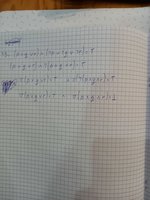You are using an out of date browser. It may not display this or other websites correctly.
You should upgrade or use an alternative browser.
You should upgrade or use an alternative browser.
Discrete math
- Thread starter Albi
- Start date
Did you see the imagePlease think about it and give it a try. Then post back with your reasoning.
We can conclude that for(p v q v r) to be true at least one p,q,r needs to be true.and for the other proposition at least one p,q or r needs to be false.I think that your teacher wants the answers in words. And yes I did see your work.
But I want to find the values of p,q and r.We can conclude that for(p v q v r) to be true at least one p,q,r needs to be true.and for the other proposition at least one p,q or r needs to be false.
pka
Elite Member
- Joined
- Jan 29, 2005
- Messages
- 11,976
I found that the directions are confusing.Hello, can you help me with the following problem.Problem 43.What should I do next?
Here is my take: We are to explain, without truth-tables, why if at least one of \(p,~q,\text{ or }r\) is true and at least one of \(p,~q,\text{ or }r\) is false then \((p\vee q\vee r)\wedge (\neg p\vee\neg q\vee\neg r)\) is true. If \(p\) is true then \((p\vee q\vee r)\) is true.
If \(q\) is false then \(\neg q\) is true so \((\neg p\vee\neg q\vee\neg r)\) is also true since both are true we have
\((p\vee q\vee r)\wedge (\neg p\vee\neg q\vee\neg r)\) is true, when we assume one variable is true and one false.


